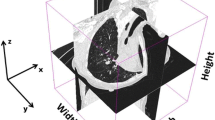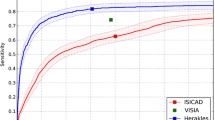Abstract
Purpose
To automatically identify small- to medium-diameter bronchial segments distributed throughout the lungs.
Methods
We segment the peripheral pulmonary vascular tree and construct cross-sectional images perpendicular to the lung vasculature. The bronchi running with pulmonary arteries appear as concentric rings, and potential center points that lie within the bronchi are identified by looking for circles (using the circular Hough transform) and rings (using a novel variable ring filter). The number of candidate bronchial center points are further reduced by using agglomerative hierarchical clustering applied to the points represented with 18 features pertaining to their 3D position, orientation and appearance of the surrounding cross-sectional image. Resulting clusters corresponded to bronchial segments. Parameters of the algorithm are varied and applied to two experimental data sets to find the best values for bronchial identification. The optimized algorithm was then applied to a further 21 CT studies obtained using two different CT vendors.
Results
The parameters that result in the most number of true positive bronchial center points with > 95% precision are a tolerance of 0.15 for the hierarchical clustering algorithm and a threshold of 75 HU with 10 spokes for the ring filter. Overall, the performance on all 21 test data sets from CT scans from both vendors demonstrates a mean number of 563 bronchial points detected per CT study, with a mean precision of 96%. The detected points across this group of test data sets are relatively uniformly distributed spatially with respect to spherical coordinates with the origin at the center of the test imaging data sets.
Conclusion
We have constructed a robust algorithm for automatic detection of small- to medium-diameter bronchial segments throughout the lungs using a combination of knowledge-based approaches and unsupervised machine learning. It appears robust over two different CT vendors with similar acquisition parameters.
















Similar content being viewed by others
References
Sharma V, Shaaban AM, Berges G, Gosselin M (2002) The radiological spectrum of small-airway diseases. Semin Ultrasound CT MR 23(4):339–351
Hansell DM (2001) Small airways diseases: detection and insights with computed tomography. Eur Respir J 17(6):1294–1313
Tasker AD, Flower CD (1999) Imaging the airways. Hemoptysis, bronchiectasis, and small airways disease. Clin Chest Med 20(4):761–773
Sluimer I, Schilham A, Prokop M, van Ginneken B (2006) Computer analysis of computed tomography scans of the lung: a survey. IEEE Trans Med Imaging 25(4):385–405. https://doi.org/10.1109/tmi.2005.862753
Webb NLMu WR, Naidich DP (2001) High-resolution CT of the lung, 3rd edn. Lippincott Williams & Wilkins, Philadelphia
Hartman TE, Primack SL, Lee KS, Swensen SJ, Muller NL (1994) CT of bronchial and bronchiolar diseases. Radiographics 14(5):991–1003. https://doi.org/10.1148/radiographics.14.5.7991828
Silva CI, Colby TV, Muller NL (2004) Asthma and associated conditions: high-resolution CT and pathologic findings. AJR Am J Roentgenol 183(3):817–824. https://doi.org/10.2214/ajr.183.3.1830817
Feuerstein M, Kitasaka T, Mori K (2009) Adaptive branch tracing and image sharpening for airway tree extraction in 3-D chest CT. In: Second international workshop of pulmonary imaging analysis EXACT09
Lo P, Ginneken Bv, Reinhardt JM, Bruijne Md (2009) Extraction of airways from CT. In: Second international workshop of pulmonary imaging analysis EXACT 09
Lo P, Sporring J, Ashraf H, Pedersen JJH, de Bruijne M (2010) Vessel-guided airway tree segmentation: a voxel classification approach. Med Image Anal 14(4):527–538. https://doi.org/10.1016/j.media.2010.03.004
Kitasaka T, Yano H, Feuerstein M, Mori K (2010) Bronchial region extraction from 3D chest CT image by voxel classification based on local intensity structure. In: Third international workshop on pulmonary image analysis, p 21
Xu Z, Bagci U, Foster B, Mollura DJ (2013) A hybrid multi-scale approach to automatic airway tree segmentation from CT scans. In: 10th international symposium on biomedical imaging: from nano to macro, pp 1308–1311
Qier M, Kitasaka T, Nimura Y, Oda M, Ueno J, Mori K (2017) Automatic segmentation of airway tree based on local intensity filter and machine learning technique in 3D chest CT volume. Int J Comput Assist Radiol Surg 12(2):245–261. https://doi.org/10.1007/s11548-016-1492-2
Estepar RS, Ross JC, Kindlmann GL, Diaz A, Okajima Y, Kikinis R, Westin CF, Silverman EK, Washko GG (2012) Automatic airway analysis for genome-wide association studies in COPD. Proc IEEE Int Symp Biomed Imaging. https://doi.org/10.1109/ISBI.2012.6235848
Kindlmann GL, San Jose Estepar R, Smith SM, Westin CF (2009) Sampling and visualizing creases with scale-space particles. IEEE Trans Vis Comput Graph 15(6):1415–1424. https://doi.org/10.1109/TVCG.2009.177
Lesage D, Angelini ED, Bloch I, Funka-Lea G (2009) A review of 3D vessel lumen segmentation techniques: models, features and extraction schemes. Medical Image Anal 13(6):819–845. https://doi.org/10.1016/j.media.2009.07.011
Frangi AF, Niessen WJ, Vincken KL, Viergever MA (1998) Multiscale vessel enhancement filtering. In: Medical image computing and computer-assisted intervention—MICCAI’98. In: First international conference. Proceedings, 11–13 Oct. 1998, Berlin, Germany. Springer, pp 130-137
Manniesing R, Niessen W (2005) Multiscale vessel enhancing diffusion in CT angiography noise filtering. In: Information processing in medical imaging. 19th International conference, IPMI 2005. Proceedings, 10–15 July 2005, Berlin, Germany, 2005. Information processing in medical imaging. 19th International conference, IPMI 2005. Proceedings (Lecture Notes in Computer Science vol 3565). Springer, pp 138–149
Palagyi K, Kuba A (1998) A 3D 6-subiteration thinning algorithm for extracting medial lines. Pattern Recogn Lett 19:613–627
Atherton TJ, Kerbyson DJ (1999) Size invariant circle detection. Image Vis Comput 17(11):795–803. https://doi.org/10.1016/S0262-8856(98)00160-7
Yuen HK, Princen J, Illingworth J, Kittler J (1990) Comparative study of Hough transform methods for circle finding. Image Vis Comput 8(1):71–77. https://doi.org/10.1016/0262-8856(90)90059-E
Hastie T, Tibshirani R, Friedman J (2003) The elements of statistical learning: data mining, inference, and prediction. The elements of statistical learning. Springer, Berlin
Cristianini N, Shawe-Taylor J (2000) An introduction to support vector machines and other kernel-based learning methods. Cambridge University Press, Cambridge
Chabat F, Hu XP, Hansell DM, Yang GZ (2001) ERS transform for the automated detection of bronchial abnormalities on CT of the lungs. IEEE Trans Med Imaging 20(9):942–952. https://doi.org/10.1109/42.952731
Mayer D, Bartz D, Fischer J, Ley S, del Rio A, Thust S, Kauczor HU, Heussel CP (2004) Hybrid segmentation and virtual bronchoscopy based on CT images. Acad Radiol 11(5):551–565. https://doi.org/10.1016/j.acra.2004.01.012
Levitzky MG (2013) Pulmonary physiology, 8th edn. McGraw-Hill Education, New York
Acknowledgements
We would like to acknowledge and thank the Commonwealth Government of Australia for the support of Daniel Moses during his Ph.D. through an Australian Government Research Training Program Scholarship.
Author information
Authors and Affiliations
Corresponding author
Ethics declarations
Conflict of interest
The authors declare that they have no conflict of interest.
Ethics standards
All procedures performed in studies involving human participants were in accordance with the ethical standards of the institutional and/or national research committee and with the 1964 Helsinki declaration and its later amendments or comparable ethical standards. For this type of study, formal consent is not required. This article does not contain identified patient data.
Rights and permissions
About this article
Cite this article
Moses, D.A., Dawes, L., Sammut, C. et al. Peripheral bronchial identification on chest CT using unsupervised machine learning. Int J CARS 13, 1379–1395 (2018). https://doi.org/10.1007/s11548-018-1805-8
Received:
Accepted:
Published:
Issue Date:
DOI: https://doi.org/10.1007/s11548-018-1805-8




